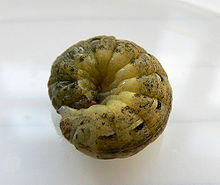- Cutworm
-
 The cutworm larva of the Large Yellow Underwing (Noctua pronuba)
The cutworm larva of the Large Yellow Underwing (Noctua pronuba)
Cutworms are not worms, biologically speaking, but caterpillars; they are moth larvae that hide under litter or soil during the day, coming out in the dark to feed on plants. A larva typically attacks the first part of the plant it encounters, namely the stem, often of a seedling, and consequently cuts it down; hence the name cutworm.
Contents
Feeding and hiding
Cutworm larvae vary in their feeding behaviour; some remain with the plant they cut down and feed on it, while others often move on after eating a small amount from a felled seedling; such a wasteful mode of feeding results in disproportionate damage to crops. Cutworms accordingly are serious pests to gardeners in general, but to vegetable and grain farmers in particular. It has been suggested that in South Africa for one, Agrotis segetum is the second worst pest of maize.[1]
Note that the cutworm mode of feeding is only one version of a strategy of avoiding predators and parasitoids by day. Many other caterpillars, including Noctuidae and some kinds of processionary caterpillars, come out at night to feed, but hide again as soon as the sky begins to grow lighter. Some, for example Klugeana philoxalis attack low-growing forbs such as Oxalis in the dark, and drop to the ground as soon as a light is flashed on them. Others will climb trees such as species of Acacia nightly, leaving trails of silk, but they leave individual trails, not common trails like processionary caterpillars. The fruit-piercing moth Serrodes partita similarly lives under litter beneath its food plant, the tree Pappea capensis[2]
Species and habits
The term cutworm applies mainly to larvae of various species in the Noctuidae, a large family of moths; however, many Noctuid species are not cutworms, and some moths whose larvae have the essentially the same habit, which justifies calling them cutworms, are not Noctuids. The larvae of the Turnip moth, (Agrotis segetum, Agrotis ipsilon, Agrotis exclamationis), are well-known Noctuids whose larvae are very damaging cutworms. Cutworms are notorious agricultural and garden pests. They are voracious leaf, bud, and stem feeders and can destroy entire plants. They get their name from their habit of "cutting" off a seedling at ground level by chewing through the stem. Some species are subterranean and eat roots.
Appearance and control
Cutworms are usually green, brown, grey, or yellow soft-bodied caterpillars, often with longitudinal stripes, up to 2.5 cm (1 inch) in length. There are many variations among the genera. There also are variations in their biology and control, so the following extension material must be applied only as appropriate to the region.
In many climates, cutworms will winter under the soil, either as final instar larvae or as pupae. This affords farmers an opportunity for control. Winter ploughing will kill many of the pests, and expose many more to predators. In suitable areas this is a powerful means of control, for example in grain fields.[1] The same principle permits some domestic gardeners to kill the caterpillars without the problems associated with the use of pesticides; the first line of control can be to till the soil some weeks before planting to destroy any dormant larvae. Also, at any time during the season, if the population has been reasonably well controlled, but there are signs of localised cutworm attack, the domestic gardener may be able to deal with the problem simply by digging the soil and wet foliage to about 2 inches deep, and killing the caterpillars manually.
Starvation also can be effective when it is practical to keep weeds down before the growing season, by systematic cultivation. Together with reducing manure and compost, relying instead on other forms of fertilizer, this can improve control by discouraging cutworm moths from laying their eggs, and depriving the larvae of food.[1]
Baits also can be effective where starvation strategies have been applied reasonably successfully; a sweetened bran mash containing a suitable stomach poison can be very effective against the small numbers of ssurviving caterpillars. The mash should be too crumbly and too thinly scattered to leave any lumps on the ground that domestic animals or desirable wild animals might otherwise pick up.[1]
Because cutworms attack the first part of the plant they find at night, plant collars made of aluminum, or even cardboard barriers, can offer effective protection.[3][4]
References
- ^ a b c d Smit, Bernard, "Insects in South Africa: How to Control them", Pub: Oxford University Press, Cape Town, 1964.
- ^ Annecke, D. R., Moran, V. C. (1982). Insects and mites of cultivated plants in South Africa. London: Butterworths. ISBN 0-409-08398-4.
- ^ Sorensen, Kenneth A., et. al. Ag-295: Insect and related pests of vegetables. The North Carolina Cooperative Extension Service. Center for Integrated Pest Management, North Carolina State University: [1]
- ^ Controlling Cutworms
Categories:
Wikimedia Foundation. 2010.
